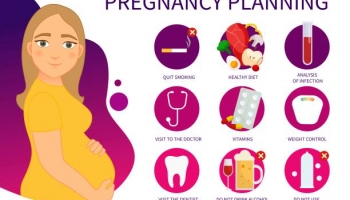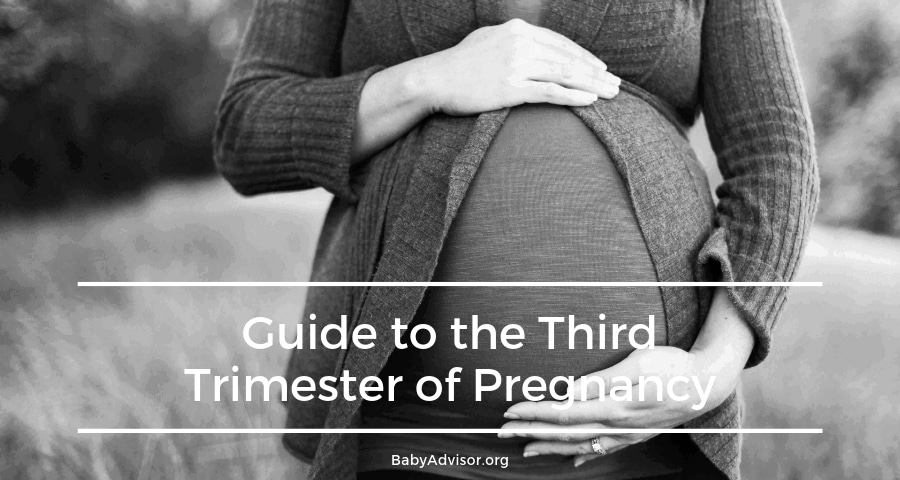

Aside from the normal aches and pains you’ve been experiencing, you’ll probably notice an increase in Braxton-Hicks contractions. You probably are feeling a bit anxious as labor and delivery looms closer, and don’t forget excitement!
Keep reading to find out what to expect during the third trimester of pregnancy.
What Happens in the Third Trimester?
Your baby will start the third trimester off around 14.8-inches which is about the size of a bowling pin. By the time your baby arrives at the end of this trimester, he will be between 19-22” (or longer!) in length and weigh anywhere from 6-10lbs.
When your baby reaches 30 weeks, he will start to gain about a half a pound each week until birth. Space in the amniotic sac gets tighter, and he gets into the comfortable, fetal positions.
Not only is your baby gaining weight, but he is also working on brain and neuron development. The brain works towards developing the neural connections necessary for the five senses. When your baby arrives, he will be able to see, feel, touch, taste, and hear. Babies even start to dream!
By 37 weeks, your baby has properly functioning kidneys and live. His brain and lungs will continue to develop throughout childhood, but all internal organs are ready to rock and roll!
Braxton Hicks - Whoa, Buddy

By now, you’ve probably felt a good deal of Braxton Hicks contractions. This is your body’s way of preparing for labor and delivery. They’re fake contractions when your uterine muscles tighten p for anywhere from 30 seconds to two minutes.
Sometimes the length and intensity of Braxton Hicks contractions can have you wondering if they’re the real deal. If you’re questioning, consider these things.
- True labor contractions don’t ease up if you change positions. So, try getting up and moving around.
- Labor contractions increase in both intensity and frequency with time.
- Try laying on your left side to see if the contractions slow or decrease in intensity.
Common Third Trimester Complaints
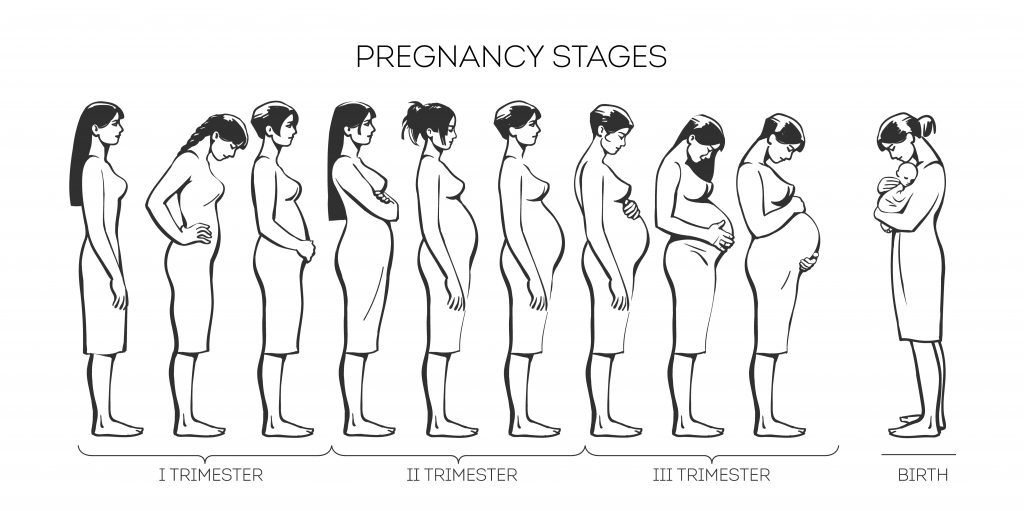
The third trimester can be difficult for many women, and there are some common complaints that comes with the third trimester. Here are some problems you might face.
1Lower Back and Hip Pain
Lower Back and Hip Pain
Aside from Braxton Hicks, lower back and hip pain is the most common complaint during the third trimester, and it makes sense why. As your body prepares for labor, the tissue in your pelvic area loosens due to the increased hormone levels in your body. These lead to hip or lower back pain.
To help relieve these problems, you can try regular exercise. Walking, stretching, and swimming is good choices. It’s during this time that your pelvis starts to spread and you develop the awesome pregnant waddle. Enjoy it, mama!
2Shortness of Breath
Shortness of Breath
As your uterus grows larger, it starts to press against your rib cage and diaphragm, making it harder for you to breathe. Trying to improve your posture gives more breathing room for your lungs. You can also prop yourself up with extra pillows if you find sleeping difficult.
3Sciatica
Sciatica
Have you noticed a tingling, numbness, or shooting pain throughout your lower back, thighs, and butt? If so, you probably have sciatica. During pregnancy, sciatica is caused by your uterus putting pressure on your sciatic nerves. A warm bath or warm compress helps to soothe your pain.
4Hemorrhoids
Hemorrhoids
Hemorrhoids are common during pregnancy, even if they’re miserable. Constipation along with the pressure on your pelvic area causes hemorrhoids. Things such as witch hazel pads, sitz baths, and other remedies can help.
Hemorrhoids are common after childbirth as well. Try to drink a lot of water and eat fiber-rich foods. Oatmeal, beans, apples, and bananas can help keep you regularly throughout pregnancy and beyond.
5Mild Swelling
Mild Swelling
Swelling is another normal problem to experience in the third trimester. You might find that your ankles or feet are swollen, especially if you spend too long on your feet. However, if you develop any sudden swelling in your hands or face, you need to talk to your doctor because it could be a sign of preeclampsia.
6Lightning Crotch
Lightning Crotch
One of the rather strange symptoms that comes during the third trimester is something called lightning crotch. It’s a silly name, but it is basically a shooting pain in your pelvic region. You might notice it more when you or the baby moves.
Preparing to Breastfeed
You’ve probably realized that your breasts are getting bigger every day, or so it feels. Believe it or not, your breasts can grow up to 2 pounds throughout pregnancy. Your nipples and areolas are, without a doubt, darker and more pronounced.
As you approach your due date, you might notice that your nipples are leaking a yellow fluid. That fluid is called colostrum, and that’s the immune-rich breast milk that your baby will drink the first few days after birth.
If you do plan to breastfeed, now is the time to start reading and learning how to breastfeed your child. You can take a breastfeeding class or read a book. You also want to make a list of essential breastfeeding supplies to have on hand. Things such as a breast pump, nursing bras, nipple creams, nursing pillows, and more are good items to grab.
More Frequent OBGYN Visits

You’re going to see your healthcare provider a lot over the next few weeks. From 28 to 35 weeks, you will go to the OBGYN every two weeks. You get rather friendly with the office staff at this point.
These appointments are generally the same. They’ll run a urine sample to check for protein in your urine. The nurse will take your blood pressure, measure your fundal height, and check to make sure the baby is moving properly.
From 36 weeks until delivery, you’ll go weekly to the doctor. Around 38 weeks, your doctor may ask to do a cervical exam to see if your cervix is opening at all (dilating) or thinning (effacing). Between 35 to 37 weeks pregnant, you’ll be scanned for Group B Strep by a vaginal swab. It’s a common bacteria that is found in 25% of healthy women.
If you do have Group B Strep, don’t fret. It just means you need a bag of IV antibiotics throughout labor and delivery to prevent your baby from contracting it from you.
Week 28
Welcome to the third and final trimester. Now, your baby is starting to take up more space, and you probably feel it! He should soon settle down into a head down position, but don’t freak out if he doesn’t yet. There is still plenty of time. Most babies settle into the head down position between 32 and 36 weeks pregnant.
Your baby is 14.8 inches and around 2.2 pounds, the size of an eggplant.
- Brain Development: In the third trimester, your baby’s brain really explodes with development. The neurons are developing at a fast rate.
- Senses Development: Along with the brain, your baby’s ears are making stronger connections. He is starting to understand some of the sounds, like identifying your voice or your partner’s voice. His eyes can easily tell when a light is shone on your belly.
- Sleep Cycles: Now, your baby is starting to dream! He has rapid eye movement (REM) sleep; doctors have been able to detect in at this stage. Who knows what little junior is dreaming about?
Start Kick Counting

At 28 weeks, doctors recommend that you start doing kick counts. You want to check on how little baby is doing in there, and the best way to make sure things are going well is by using a kick count.
Here’s what to do. Pick a time per day and set a time. See how long it takes to get 10 fetal movements. You want it to take two hours or less. Then, do the same thing the next day. Record the times for each day, so you can find an average range for your baby. It’s a great way to let yourself (and your doctor) know things are really fine in there.
If the times aren’t consistent, be sure to talk to your doctor.
Week 29
Is your baby feeling like a little kickboxer in there? Now is the time to start finalizing details for the baby shower and your nursery. Figure out what you want to register for and make a baby registry. You’re 11 weeks away from your delivery, but those weeks go fast.
Your baby is around 15.2 inches long and 2.5 pounds, the size of acorn squash.
- Working Reflexes: Your baby is starting to develop those important reflexes that he will need outside the womb, like combing. His startle reflex, called the Moro Reflex, is also developing.
- Hair: More and more hair is developing on top of her head right now, and your baby is growing eyelashes!
- Strong Bones and Muscles: You probably realized that his kicks are getting stronger. That’s because his bones and muscles are stronger, and they will continue to get stronger throughout the third trimester.
Lots of Baby Fat
Until now, your baby was pretty much see-through, which is strange to think about! Now, he is starting to develop and grow white fat deposits under the skin. Baby fat helps to get rid of transparency, but baby fat is necessary to help regulate your baby’s temperature once they come out into the real world.
Now is the time when your baby has more energy. Fat is how we store energy, and energy is needed for our brain development. It makes sense that your baby would develop more fat when he is also working on those big brain developments as well.
Week 30
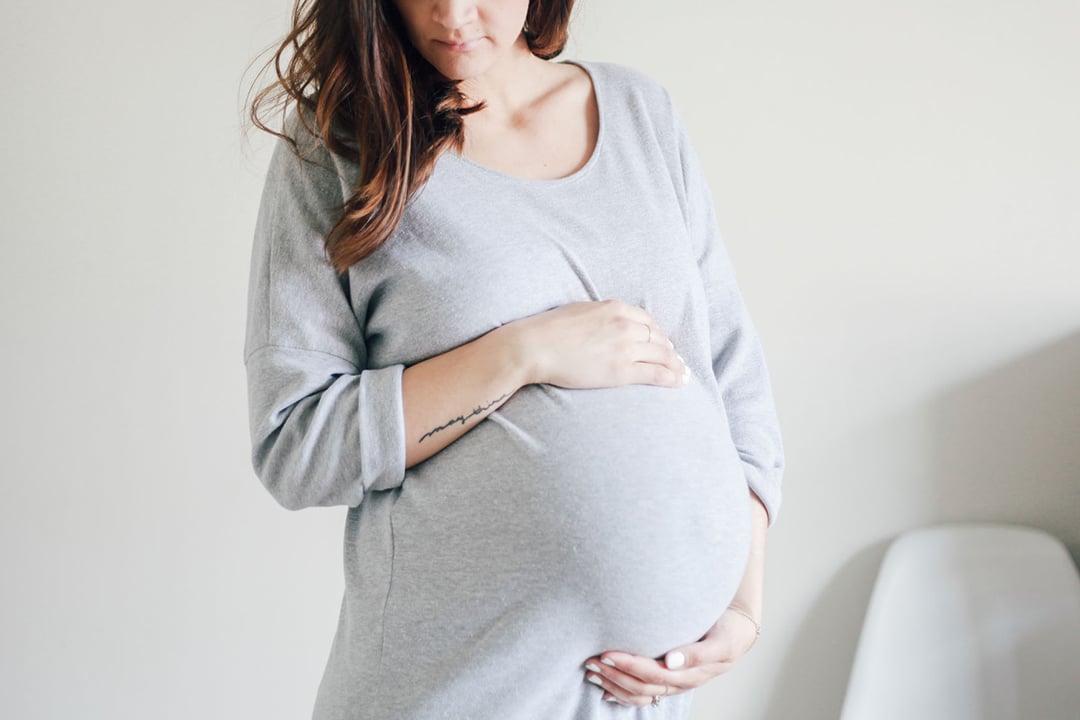
You’re in the last ten weeks of your pregnancy, and you’re probably feeling pretty pregnant by now. Everyone knows your belly – it’s kind of hard to miss. It makes sleeping a bit challenging, but it’s only for a few more weeks.
Your baby is 15.7 inches and 2.9 pounds, the size of a zucchini.
- Lots of Kicks: Make sure you’re doing those kick counts! You might feel fewer karate kicks and more movement because space is at a premium in there. Follow the directions for kick counts to make sure everything is okay in there.
- Lung Development: Your baby’s lungs are getting stronger as your baby prepares to take his first big breath. They still have a few more weeks until they’re ready to go.
UTIs and Pregnancy
Let’s talk about something not-so-fun: UTIs. You might not know this, but you’re more prone to UTIs when you’re pregnant. UTIs are bladder infections that happen when bacteria enters the urinary tract and bladder. Your uterus sits on top of your bladder and becomes heavier each day. It can stop urine from fully draining, leading to a UTI.
UTIs aren’t something to mess around with, and they’re not comfortable. They do need to be treated with a pregnancy-safe antibiotic. If you don’t treat a UTI, it can lead to a kidney infection and, possibly, preterm labor. You don’t want to risk that.
Signs of a UTI include:
- Pain or burning while urinating
- Needing to urinate more often (even more so than you did just being pregnant)
- Chills, fevers, sweats, and/or leaking pee
- Waking up to pee
- Cloudy or foul-smelling
- Blood or mucus in the urine
- Pain during sex
- Cramps or pain in your lower abdomen
If you notice any of these signs, be sure to speak to your doctor.
The best thing to do is to work towards avoiding UTIs. A few prevention methods include:
- Staying well-hydrated by drinking 6-8 glasses of water each day.
- Drink unsweetened cranberry juice
- Cut back on refined foods, caffeine, and sugar.
- Use the bathroom when you feel the need to pee
- Always urine before and after sex
- Wipe front-to-back
- Wear underwear made of breathable material, like cotton
Week 31
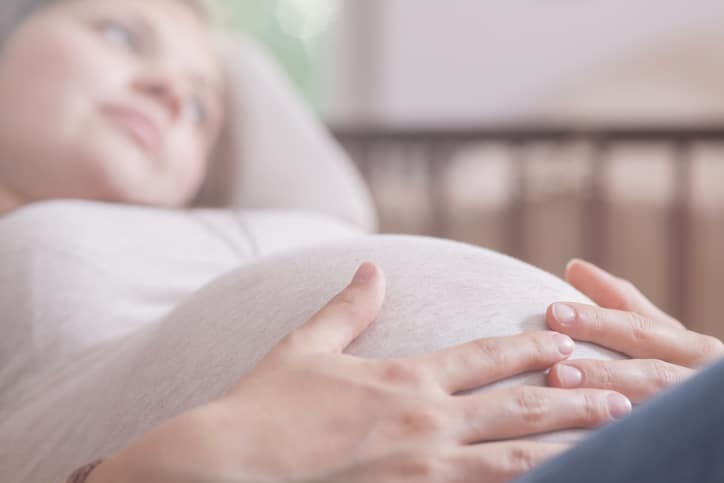
Are you feeling a little absent minded? That’s normal, and most call it “pregnancy brain.” Some moms find that they are acting more absentmindedly during the third trimester. Who can blame us? We have a lot on our mind, and our bodies are doing a lot of work in there.
Your baby is 16.2 inches long and 3.3 pounds, the size of a bunch of asparagus.
- Five Senses: With all that brain and nerve development, those five senses are really working hard. The irises can now react to light, which is awesome. All five senses are in working, proper order, ready for birth.
- Changing Position: Now is when your baby is starting to nestle into the comfortable fetal position as the womb gets tighter. He should be head down or considering the turn to be head down. Speaking of heads, your baby can move his head from side to side, strengthening those neck muscles.
Common Body Issues at 31 Weeks Pregnant
- Nail and Hair Changes: Some women get strong, long nails, great skin, and luscious hair. Other women aren’t as lucky. Some women experience very brittle nails throughout pregnancy. Your nails might even start to chip, but they do go back to normal after delivery, don’t worry.
- Trouble Sleeping: As your baby gets bigger and his movements are stronger, you might feel like your baby is having a dance party on your uterus. That’s not cool, and now you just want to sleep. Plus, you have to battle pregnancy symptoms like leg cramps, heartburn, back pain, and more.
It’s a lot to deal with, that’s for sure. Try to stay well-hydrated; that’s key throughout all of your pregnancy. Work on creating a relaxing, calming nighttime ritual that will soothe your brain and body. Get comfortable with pillows and blankets. Also, getting proper exercise helps to get more shuteye throughout the night.
Week 32
Now is about the time when you might be having your baby shower. It’s also a great time to start finalizing plans. Do you have your maternity leave paperwork completed? Make sure your insurance is aware of the pregnancy and you probably are trying to finish up that nursery sooner rather than later. Don’t worry though; you still have time to prepare.
Your baby is 16.7 inches long and 3.8 pounds, the size of a squash.
- Sucking and Swallowing: Your baby is working to develop even more reflexes now. During 32nd week, your baby starts to practice sucking and swallowing. Doing so prepares their digestive system for drinking milk at birth.
- Breathing: Now that your baby’s lungs are working hard on development, your baby has to start practice breathing by inhaling amniotic fluid.
Pregnancy Discharge
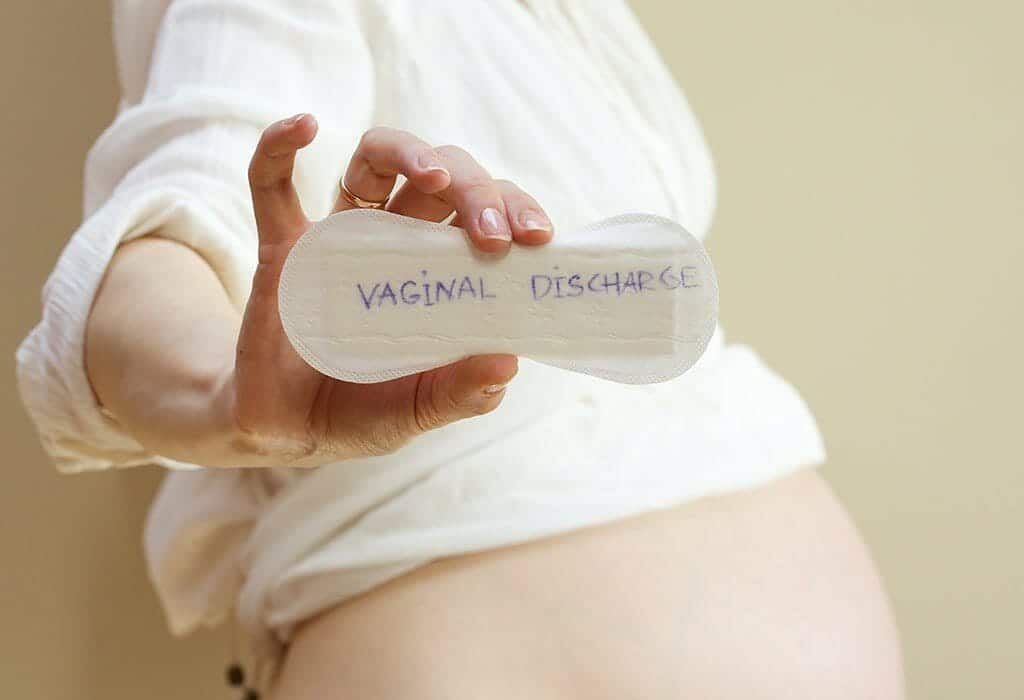
As you get closer to the end of your pregnancy, you might notice even more vaginal discharge than before. You’re thinking that’s just great, but it’s normal. You can blame it on pregnancy hormones and the increase in blood flow around your uterus.
Typically, you just toss on a pantyliner and be done with it. However, there are times when a vaginal discharge isn’t as normal. If it goes to a sudden or visible change, it could be a sign of an infection or an STD.
Now you have to think about labor as well. If the liquid is thin and either a long trickle or a gush, it might mean that your water broke. That means you need to go to your doctor immediately.
As you get closer to labor, you might find thick, blood-tinged discharge. This is called your mucus plug, and it means that your body is preparing for labor. Just because you see your mucus plug doesn’t mean you will go into labor soon. Mucus plugs can, believe it or not, regenerate.
Week 33
33 weeks is a great time to start packing up your hospital bag and diaper bag. You want to make sure you read about postpartum care and stock up on the necessary items you need, but the hospital will supply you with your essentials throughout delivery.
You’re probably feeling pretty excited, but it might be a bit masked by your discomfort. You might be sore, overheated, and tired. Pregnancy can be rough.
Your baby is 17.2 inches long and 4.2 pounds, the size of a head of celery.
- Hardening Bones: Now, your baby’s bones start to harden up. There will still be the soft spot on the top of his head at birth, which allows your baby to move down through the birth canal. These soft spots are called fontanelles which are between parts of their skulls. It takes a few years – yes, years – to close them up. That’s one reason why you do need to be careful with your baby’s head after birth.
- Immune System: Your baby’s immune system depends on you. Right now, you’re passing antibodies to your baby to prep their developing immune system. Babies are still more vulnerable at birth.
Things You Might Be Feeling
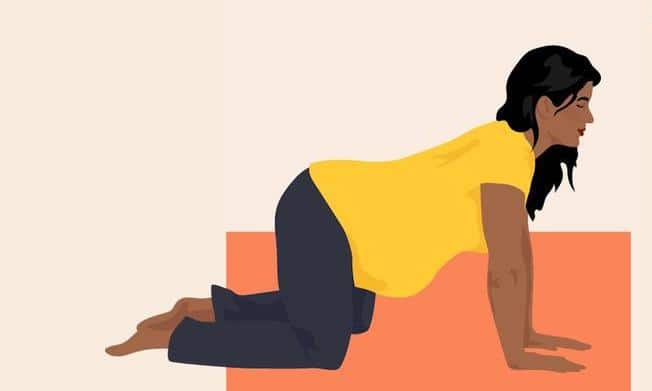
There is plenty of discomfort going on when you’re 33 weeks pregnant. A few things you might be feeling include:
Right now, your metabolic rate is much higher than normal, so you tend to feel hotter. If it’s cold outside, you might be walking around without a coat. You have your own personal heater, or so it feels.
Your hormones are still fluctuating, which can cause headaches. You also might be stressed or dehydrated. Make sure you take it easy and drink as much water as possible. Dehydration during pregnancy is never a good thing.
By now, you’re probably used to feeling like you aren’t able to catch your breath. When your baby finally drops and frees up space under your lungs, you’ll notice that you’re finally able to breathe better. This can happen at different times for every mom, so it could be soon or you might have some time left to wait.
Understanding the Stages of Labor
Now is a good time to start educating yourself on what labor looks like. It’s not one big event, but rather, a process of stages. Every labor is different, but you should know the stages and how they progress to help you prepare for your birth!
- Early Labor: This stage of labor is mild and the easiest, if there is such a thing as easy labor. It’s often the longest, and you’ll feel like it’s dragging on forever. You will dilate up to three centimeters.
- Active Labor: During active labor, the contractions start to increase in frequency, and they will start to feel more intense as well. You’ll dilate from three to seven centimeters.
- Transition: Transition is the hardest, even if you have pain relief. It’s often the shortest, which is great, and it can last for a few minutes to a few hours. You’ll dilate from seven to 10 centimeters.
- Pushing: The big moment has arrived. Once the transition is over and you’re fully dilated, it’s time to push. You might feel an urge to push, or you might be coached by a medical team. Then, in the end, your baby will be born.
- Delivering the Placenta: Once the baby comes out, labor continues and you have to deliver the placenta. It usually only takes a few pushes.
Week 34

You have a little eavesdropper in there. Your baby can hear all the voices around you and listens to your conversations. He enjoys music and hearing a lullaby. Go ahead and sing out loud a lot. Some experts believe that babies can recognize the songs that mom sang during pregnancy, making it easier to soothe the baby. How cool is that?
Your baby is 17.7 inches long and 4.7 pounds, the size of a butternut squash.
- Nervous System: Now, your baby’s central nervous system is fully developed. His brain development and power will continue to increase, and his brain is going from a smooth organ to wrinkly, which means he’s getting smarter.
- Breathing Fluid: Your baby is still working on developing his respiratory system. Lungs need a few more weeks to grow and mature, so your baby is practicing breathing. He inhales amniotic fluid over and over again, which sounds weird, but it’s perfect.
- Vernix: Now, your baby has a thick coating of Vernix caseosa, which is a cheesy-like substance that keeps your baby’s skin soft. It’s starting to thicken even more. It sounds gross – who wants a cheesy baby? However, it plays a vital role in birth.
Is Sex Still Ok?
By now, your belly is in the way, and sex might be uncomfortable. Some women love the feeling of pregnant sex, so it’s a personal thing. A surging libido and a declining sex drive both are normal.
So long as your doctor gives you the thumbs up, sex is safe during the end of your pregnancy. It might be a bit awkward because of your large belly, but that means you get to try some different, creative positions.
Something else you might notice is belly tightening after sex. Orgasms can give you contractions, and that’s normal. You may notice them more now that your belly is so much bigger.
However, if those contractions come with other issues like a fever, heavy spotting or bleeding, vision changes, and headaches, then you need to talk to your doctor.
Week 35
You’re T-minus 5 weeks until delivery, and it’s definitely time to make sure you start to finalize details. Get the nursery finished and grab whatever else you need before the baby arrives. Some babies don’t wait until 40 weeks to arrive.
Most of all, try not to stress. That’s always easier said than done, but things always come together with the way that they’re supposed to come together. Create a list of the things you need to do and what you want to do. Work down the list based on priority.
Your baby is 18.2 inches long and 5.3 pounds, the size of a pineapple.
- Kidneys and Liver: On the organ development news front, your baby’s kidneys and liver are in working order. They are starting their processes and working now.
- Growth Starts to Slow Down: Around now, your baby’s growth will start to slow down a bit. They’re still continuing to put on the ounces, gaining fat and adorable chubbiness. However, babies only grow a few more inches before birth at this point.
Signs of Labor
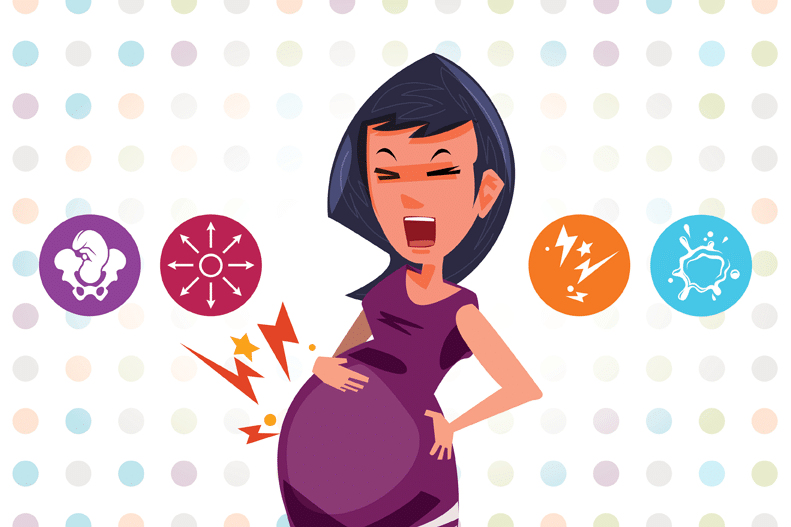
Now is a good time to think about and understand the true signs of labor. Did you know that around 11 percent of moms give birth prematurely? Twin moms are considered almost full-term by 35 weeks, so it’s a good time to figure out the signs that truly matter.
So, here are the real deal things that warrant a call to your OBGYN and a trip to the hospital.
- Water Breaking: So, some women experience a trickle, and they think they peed themselves. Those things happen in labor. It can happen as a big gush – think of a movie – but it can be a slow trickle. Lay down and then stand up. Does it stop or does it continue? When your water breaks, it will continue to come out.
- Painful Contractions: Braxton Hicks contractions don’t lay a finger on what real contractions are like. If you suddenly have painful, intense contractions that come at timed intervals, you’re probably in real labor.
- Regular Contractions: Real contractions don’t stop. They become regular, more frequent, and more painful. The general rule of thumb is to go to the hospital when they’re about 5 minutes apart. If this is your second baby, you may want to go in a bit earlier because some second (and later) labors do go faster.
- Mucus Plug: If you find a gelatinous mass in your undies or toilet, it could be your mucus plug. It’s kind of like discharge, but way more gross. The job of the mucus plug is to seal off the opening of the uterus. As your cervix starts to change and get ready for delivery, the mucus plug is released. It may or may not come with a bloody show.
- Bloody Show: A bloody show is a blood-tinged discharge that is caused by the bursting of some blood vessels near the cervix as it starts to dilate. Some women see this, and some don’t. Don’t worry either way; it’s normal.
You still should be gaining around a half pound to pound each week until you give birth.
Week 36
Wow, you’re in your ninth month of pregnancy. Isn’t that crazy? This is your last month of pregnancy, and before you know it, you will have your baby in your arms. Now is the time for any final prep work. Go over and review any plans to get to the hospital and finalize any childcare plans if you have other children. Make sure to keep your boss and colleagues updated so they know what’s happening.
Your baby is 18.7 inches and weighs 5.8 pounds, the size of a papaya.
- Digestive System: Right now, the major thing that your baby needs to work on is the development of his digestive system. Your baby hasn’t had any milk yet, so it takes time for their stomach to get up and running. Don’t worry; it’ll be working on full-steam by the time your baby arrives.
- Blood Flow: Your baby is getting ready to meet the world. Now, his blood circulation is fully up and running.
- Time to Shed: All that downy hair on your baby’s body is starting to come off now as well as the vernix. That’s because you’re getting closer to labor and delivery.
Understanding the Group B Strep Test
Around 35 to 37 weeks pregnant, your doctor will run a Group B Strep test. This test is to determine if you have a called Group B Strep – surprise! The test is simple. Typically, you will have a quick swab around your vagina opening and anus. It sounds weird, but it’s fast.
If you do have GBS, don’t panic. It’s nothing that you did wrong. You might never have noticed that you had anything wrong, or it could cause a problem like a UTI. However, GBS can cause severe issues for your new baby, and it can be life-threatening.
Around 10 to 30 percent of pregnant women have positive results for their Group B test. The solution is quite easy. All you have to do is get an antibiotic drip throughout your labor. Doing so greatly reduces the risk of spreading GBS to your baby.
Week 37
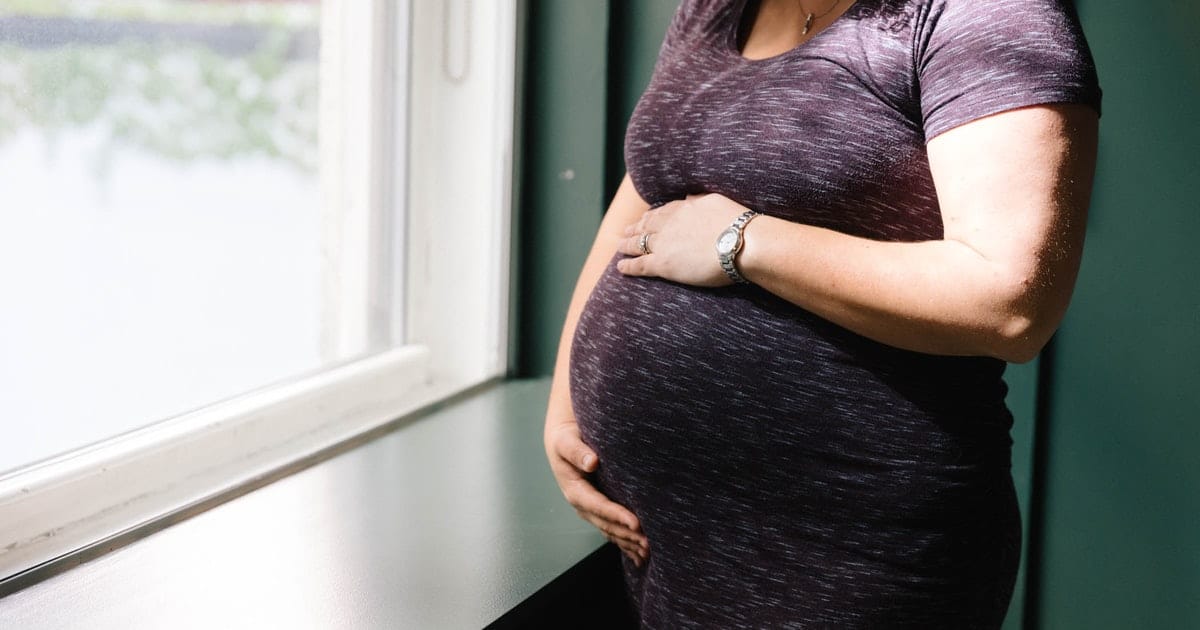
You’ve officially reached early term. You want your baby to stay in for a bit longer, but, for years, 37 weeks was considered full term. Some moms find themselves feeling like they need to clean – a lot. This is called nesting, and it’s instinctual. Your body realizes that the baby is going to be here soon, so your brain wants to make sure you’re well-prepared for the arrival of your baby.
Your baby is 19.1 inches long and 6.3 pounds, the size of a head of romaine lettuce.
- Dexterity: Now, your baby’s fingers are more coordinated as they learn how to grasp and hold things. He loves to grab onto his umbilical cord and their own hands. Then, at birth, babies love to grab your pinkie finger.
When Is a Baby Considered Full Term?
The definition of when a baby is considered full term is a bit tricky. Your pregnancy is officially full term when you hit 39 weeks. That’s when you know you have a fully baked baby.
However, some people say that 37 weeks is full term, so which one is it?
In the past, any pregnancy lasting over 37 weeks was considered full term. Now, OBGYNs have changed the classifications, since every single week does make a difference in fetal development. Babies born at 37 and 38 weeks aren’t always as healthy as those born at 39 and 40 weeks. The brain, lungs, vision, hearing, and more still have more to develop, and they need to put on more weight.
The classifications go like this:
- Early Term: 37 weeks pregnant through the end of 38 weeks pregnant.
- Full Term: 39 weeks until the end of 40 weeks pregnant
- Late Term: 41 weeks pregnant through the end of 41 weeks
- Postterm: 42 weeks pregnant and beyond
Week 38
By now, you’re feeling a mixture of excitement and nervousness, along with a bit of anxiousness. Baby is doing all kinds of things in there, like bumping nerves and making you feel a little over pregnancy. Make sure you’re on the lookout for labor signs. You’re slowly getting to the point when you might go into labor, so pay attention!
Your baby is 19.6 inches long and 6.8 pounds, the size of winter melon.
- Vocal Cord: Your little baby has fully developed vocal cords, so they can communicate when they’re born. Communication means crying, in case you’re wondering.
- Large Heads: One thing you should be aware of is that babies are for their huge heads, which is caused by their massive brain development in utero. His head has the same circumference as their abdomen does.
Itchy Belly
Sometimes, you might notice that your belly is itchy. Your belly is stretched pretty much as far as it can go, so it’s more sensitive. Hydration can help. You should try a heavy-duty moisturizer. Many moms swear by pure shea butter and drink a lot of water.
If you develop any sort of rash, make sure to speak to your doctors.
Cervical Changes During Labor
As labor gets closer, it’s a good idea to try to understand the terms that will be used when you’re delivering your baby. Your cervix has the most changes during labor, and your doctor will do pelvic exams at the end of your pregnancy to see if you’re dilating or effacing.
What do those terms even mean?
-
Dilation
Cervical dilation is the opening of your cervix, and it needs to happen before you can birth your baby vaginally. Your cervix starts at 0 centimeters, which is totally closed. As your uterus starts to contract during labor, it starts to open the cervix more until it reaches 10 centimeters. At this time, your baby can come out of the cervix.
-
Effacing
As your cervix starts to dilate, it’s also thinning, or effacing. Effacement is measured with a percentage. 0% is completely firm and 100% is paper thin.
Week 39
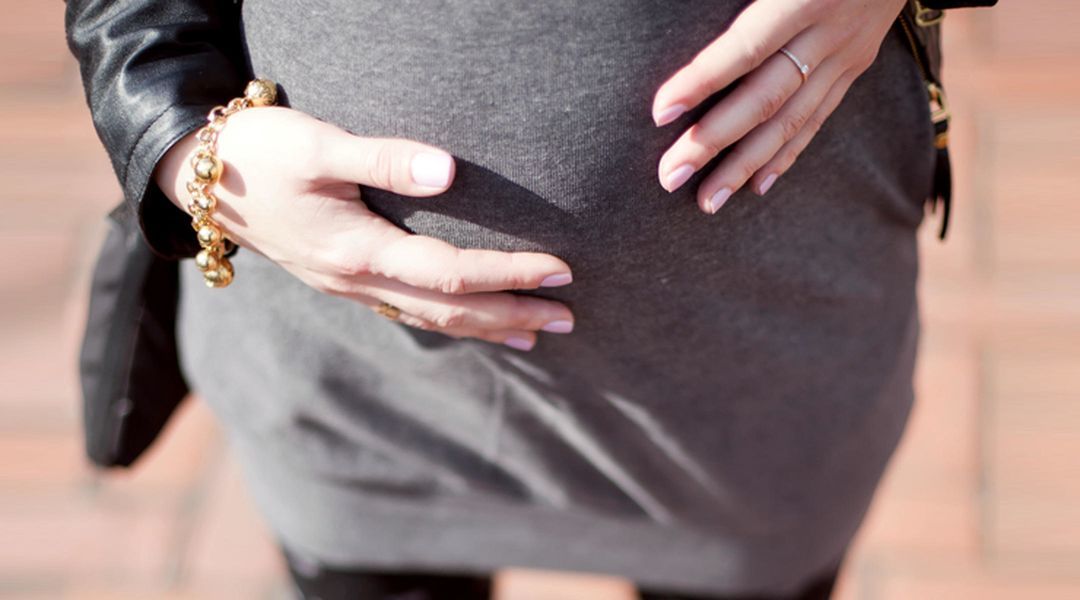
You’re officially full term. Your baby can come at any time, and everyone would be okay. That’s an awesome feeling, but it doesn’t mean that the baby will just come out any time soon. You’re for sure feel impatient and definitely uncomfortable.
Your baby is 20 inches long and weighs around 7.3 pounds, the size of a pumpkin.
- Officially Full Term: Your baby is officially considered to be full term. Even though your baby is technically ready for birth, they’re still adding fat deposits which are important for brain development.
- Fewer Large Movements: You might notice that your baby isn’t kicking and moving around as much as before. It’s tight in there! Just because the movements aren’t as sharp, they should be just as regular. He isn’t going karate kicks, but more rolls and elbow jabs.
- Skin Cell Regeneration: Your baby is now able to form new skin cells to replace the older ones. After birth, new skin cells help to regulate body temperature.
Positions During Labor
Once you’re in labor, you may want to try some different positions that are more comfortable and let baby descend easier. A lot of moms find reclining with feet in stirrups comfortables. Others prefer a birthing chair or stool.
Make sure you call your birthing facility ahead of time and ask what you can bring and what they offer. Some hospitals have birthing balls, peanut balls, stools, and more available to moms.
Some providers are comfortable with you birthing in different positions as well, such as on your hands and knees or on a birthing stool. Most importantly, you have to find what you’re comfortable doing and what works best for your baby.
Week 40
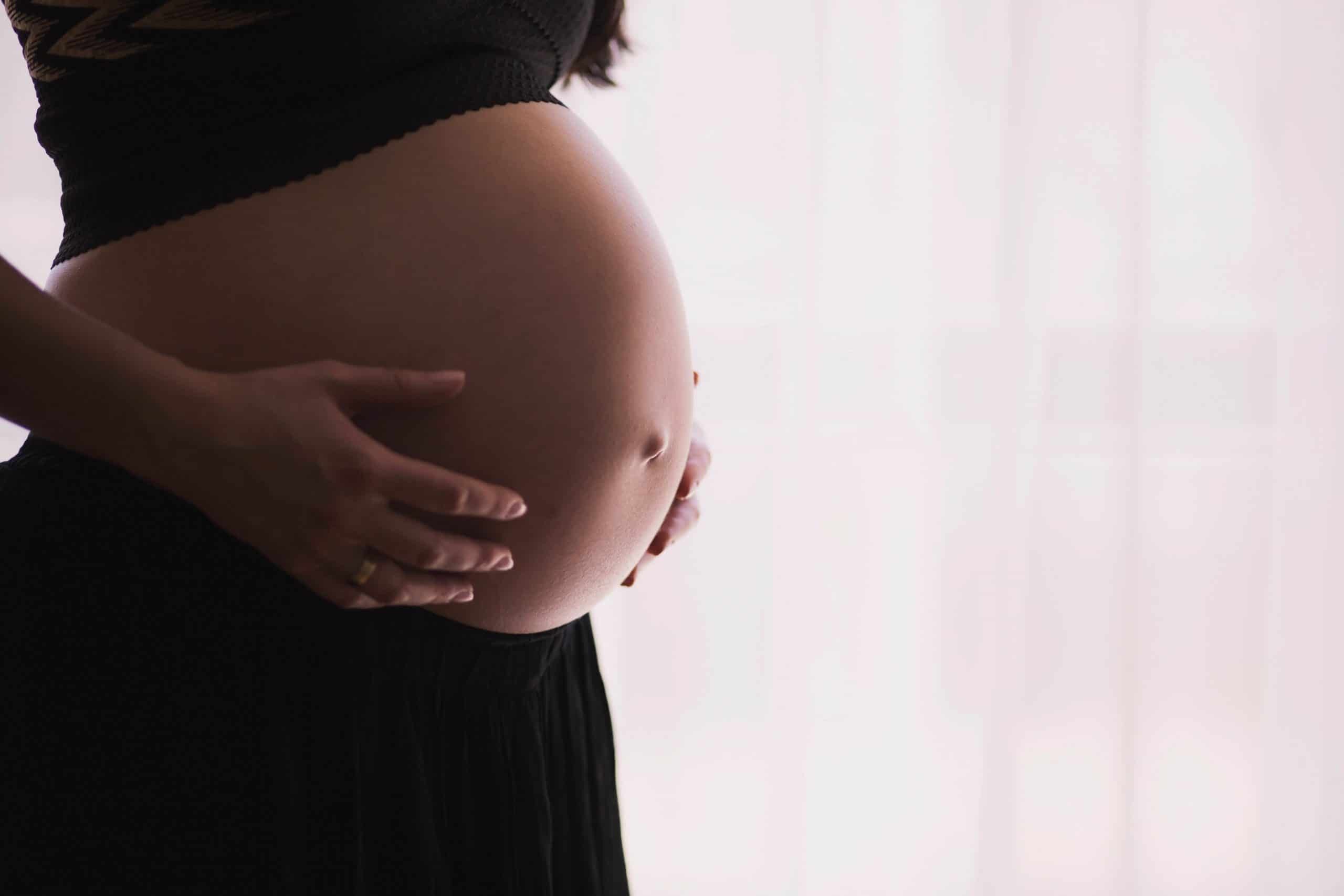
Happy due date! You should be totally ready for your baby to arrive with the installed car seat, a packed hospital bag, and everything else ready to go. This week can be stressful because you’re always on the lookout for signs. Is that cramp the start? Does this twinge mean something is happening? Your body will let you know when it’s time for your baby to arrive.
Your baby is around 20.2 inches and 7.6 pounds, the size of a watermelon.
- Slower Growth: By 40 weeks, your baby’s growth starts to plateau because they don’t have much more room to grow!
- Harden Bones: Your baby’s bones are hardened except for the skull. The soft spot in your baby’s head allows your baby to descend into the birth canal. That’s why some babies have cone-shaped heads, but your baby’s head will round out nicely soon.
Manage Visitors Once Baby Comes
Everyone wants to come to meet the baby, and it can be hard to tell those you love and care for no. You have to balance your needs with their desires. Your needs trump everyone else’s wants – just so you know.
Here are some tips for helping manage visitors.
Make a list of what would be helpful for people to do for you. If they ask you what you want to be done, refer to the list. You might include things like folding clothes, making something for lunch, or vacuuming the floor.
Set Limits Now
Let people know who you do (and don’t) want in the delivery room. Let them know who can visit you in the hospital, and who you want to visit you in the first days and weeks after birth. It can be hard to tell people you might not be up for visitors, but your mental and physical health is most important.
Don’t Entertain
You don’t have to cook or clean your home for guests. You have to heal – you have a huge wound inside of your uterus. You aren’t expected to entertain guests. All you have to do is take care of yourself and your baby.
Expect to Not Feel Yourself
Hormones are crazy! You might feel angry, sad, or what more sensitive. How you handle postpartum hormones is different than how your friend might handle them. That’s okay! Make sure you avoid situations that might be overwhelming or cause drama.
Past 40 Weeks and Beyond
You’ve been counting down your due date, but now it’s here and gone. You might have thought about the possibility of going past it. Going past your due date is quite normal, but it can feel frustrating. You’re ready to meet your baby!
Every hospital and doctor has different policies, but between 41 and 42 weeks, your doctor will discuss induction options. The baby has to come out – one way or another!
You did it! You delivered your baby. Congratulations! We hope our pregnancy guides help you understand the weeks ahead of your pregnancy.




